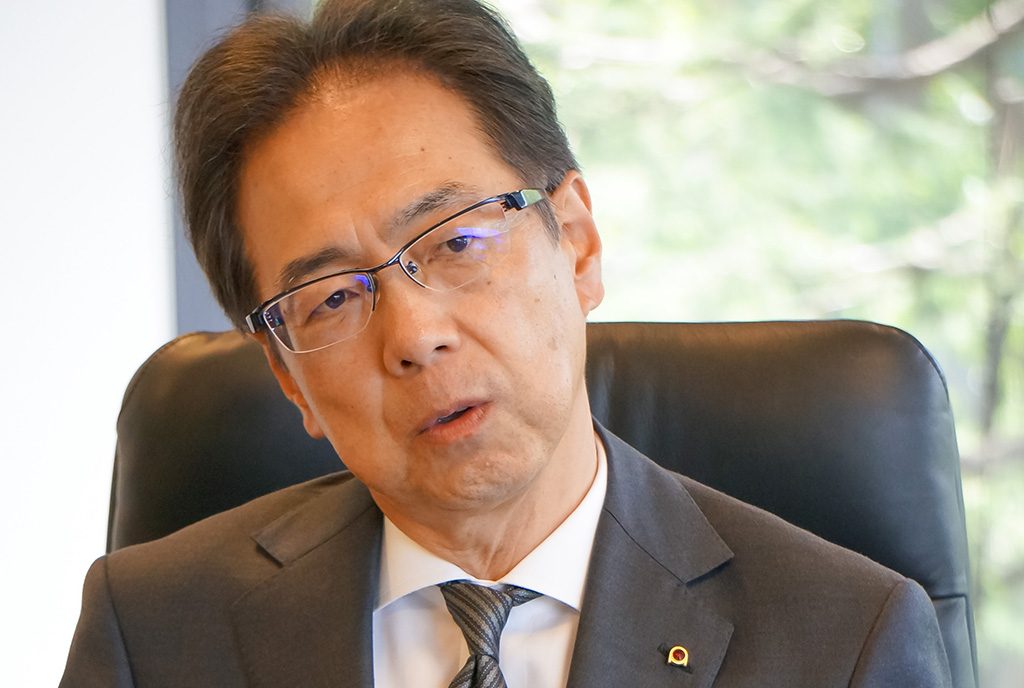
- News
- Basics
- Products
- JP Job shop
- Exhibition
- Interview
- Statistic
- PR
- Download
- Special contents
Interview
July 19, 2019

Interview with Tsutomu Isobe, President of AMADA HOLDINGS
Facilitate the production reforms of customers
Mr. Tsutomu Isobe, president of AMADA HOLDINGS, a manufacturer of various metalworking machines, points out that for their flagship fiber laser cutting machines “there are still large markets that can be targeted.” They support the production reforms sought by their customers with solution and automation proposals. AMADA HOLDINGS will exhibit a variety of sheet metal processing machines and stamping press machines at MF-TOKYO 2019, which starts on July 31, 2019.
— How is the current business sentiment?
The economy seems to be in a lull due to the effects of US-China trade disputes. However, only 20 to 30 percent of our customers say distinctly that the economy is bad. More than 70 percent of them say that they still have sufficient workloads. We have heard a customer who specializes in advanced precision sheet metal processing for fields such as medical equipment say, “We are too busy to take new jobs”.
— How is the business sentiment by industry?
Good business situations have been maintained in fields related to medical equipment as I mentioned before, as well as in fields related to building materials and construction. In addition, we are also expecting a lot in fields related to semiconductors and machine tools, as some customers receives specific requests to prepare for an increase in production.
— It is a situation you cannot talk about collectively, isn’t it?
Elevators, automatic vending machines, and automatic ticket-vending machines have deeply permeated Japanese society, and sheet metal processing machines are used in every field in such industries. There is constant replacement demand for sheet metal processing machines in these fields, with the potential for the introduction of new models in connection with replacement. The challenge for customers is how to reform their production in order to accept a new model. Our job is to facilitate their production reforms to meet the challenge. New needs are increasing: for example, laser cutting machines that can cut the high-reflection materials like stainless steel and aluminum at high speed and with high quality, as well as loading/unloading equipment for materials to support such things as high-speed cutting machines. Responding to this, we have recently enhanced our solution proposals for advanced processing technology and automation proposals to resolve labor shortages.
— What are the trends in the market for laser cutting machines, core products of AMADA?
Fiber laser cutting machines accounted for about 80 percent of sales of laser cutting machines in fiscal 2018. Some people say, “Fiber laser cutting machines have already spread as far as they can”; however, the majority of the existing machines are CO2 laser cutting machines. Assuming that all of them will be replaced with fiber laser cutting machines in the future, I think that there should be replacement demand for about the next 10 years, based on a simple calculation.
— It has been believed that CO2 laser cutting machines are suitable for thick sheet metals plates and that fiber laser cutting machines are suitable for thin sheet metals; however, the application range of fiber laser cutting machines with high-output oscillator has recently been expanded.
There are 4 patterns in which fiber laser cutting machines are sold. The 1st pattern is switching from CO2 laser cutting machines. The 2nd pattern is switching from a punching machine (turret punch press). The 3rd pattern is switching from other companies to our company. The 4th pattern is when a newly founded sheet metal processing company in a developing country starts using fiber laser cutting machines for the first time. Considering each of these cases, we can see that there are still markets that can be targeted. I think that there are many large markets even in developed countries, including Japan.
………The second part of this article will be uploaded on July 22, 2019
Source:SEISANZAI MARKETING Magazine July 2019 issue
October 24, 2025
August 22, 2025